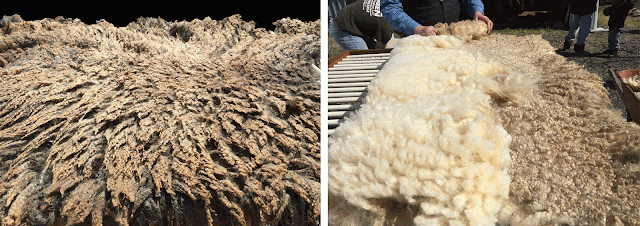 |
| Sheep in queue |
Sheep shearing 2016
When scheduling a shearer for an early spring shearing, a major concern is rain. Everybody gets wet (and cold) and finding a covered place for the skirting table just adds one more planning element to an already crazy-busy day.But this year's March day couldn't have been better. It was a spectacular meteorological gem. Sunny, dry and cool. Just perfect.
This year there were only eight ewes to be shorn and M. and I were able to stay ahead of the shearer--if only just barely. With years of experience, Hoyt Emmons shears each sheep smoothly and efficiently. Once he is done and steps aside, the quickly haltered sheep gets personalized care and its fleece moves to the skirting table.
Stage two: Skirting
My standing assignment is at the skirting table. You can see the table in the photo at right below. It's a large wooden frame fitted with spaced PVC pipes that roll, allowing unwanted pieces to fall through. After identifying which end is which, that is, head vs. rear, the work begins.
The sheep at Winters' Past Farm wear coats, which keeps their fleeces clean, so most of the fleece needs no special attention. But what was outside the coat--the neck and upper chest and the belly wool in particular--does. The head and neck area often has so much vegetative matter that it must be removed. The back end has its own issues, but it's a straightforward cleanup, as are the belly sections. As Kris reminds us, anything that clunks, goes.
Once skirted, the fleece is folded into thirds, rolled up, bagged and tagged. This is the first round of cleanup. Kris will meticulously skirt the fleeces again sale.
You may recall my frustration last fall when I assumed ownership of an orphaned sale fleece that was so contaminated with excrement and vegetation that after picking through it, only a fraction of the fleece--about one and a half pounds--was usable.
 |
| The last fleece comes off--and what a beauty! |
There was some dismay, but no surprise, when one ewe's fleece had a break in her wool. She'd had a stressful winter after she added quadruplets to the flock.
But the last sheep in queue was a beauty. Just look at that fleece!
I almost--hear that? almost!--broke my vow and bought the fleece right then and there. It is that nice.
 |
| I don't know what was more fun to watch--the lambs or the kids at play. |








